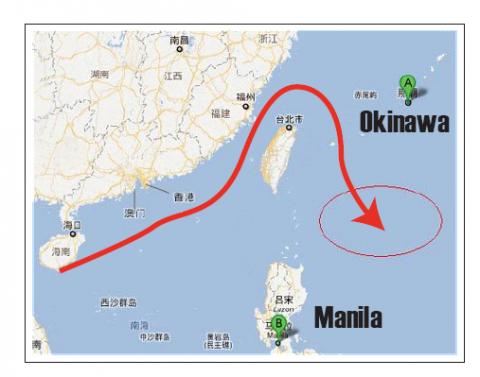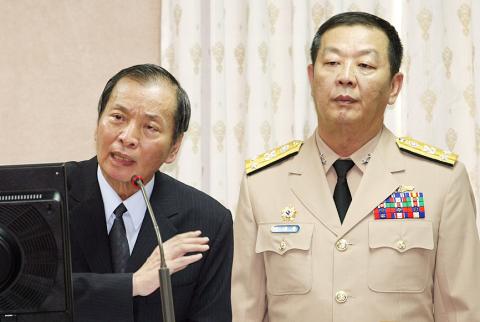|
Taiwan monitors
Chinese naval moves
CURVEBALL: In exercises that could threaten
Taiwan as much as the Philippines, five Chinese warships passed through the
Taiwan Strait before heading for the Pacific
By J. Michael Cole / Staff reporter


Deputy Minister of National
Defense Chao Shih-chang, left, answers questions about Chinese naval exercises
at the legislature yesterday.
Photo: CNA
The Ministry of National Defense is paying
close attention to ongoing maneuvers southeast of Taiwan by a fleet of Chinese
navy vessels that includes one of the heaviest combat ships in the People¡¦s
Liberation Army Navy.
According to Japanese media, the Japan Self-Defense Forces first spotted the
group of five Chinese vessels 650km southwest of Okinawa on Sunday after they
had crossed the Strait of Miyako.
The five vessels from the Chinese navy¡¦s South Sea Fleet ¡X Type 052B destroyers
Guangzhou and Wuhan; Type 054A frigates Yulin and Chaohu; and Type 071 landing
platform dock (LPD) Kunlun Shan ¡X left from Hainan Island and entered the Taiwan
Strait, before making a right turn about 180km off Taiwan.
At 18,000 tonnes, the Kunlun Shan is one of the largest combat vessels in the
Chinese navy. The LPD, which can support a reinforced battalion of as many as
800 marines and can carry landing craft and medium-sized helicopters, took part
in anti-piracy operations in the Gulf of Aden in 2010.
After entering the Pacific, the vessels conducted tactical formation and
helicopter training missions in international waters about halfway between
Taiwan and the main Philippine island of Luzon.
Aside from a Taiwan contingency, Chinese LPDs could play a crucial role in
operations in the South China Sea against countries such as the Philippines and
Vietnam, with which Beijing has become embroiled in disputes over contested
islets.
Commenting on the developments, Deputy Minister of National Defense Chao Shih-chang
(»¯¥@¼ý) told the legislature¡¦s Foreign Affairs and National Defense Committee
yesterday that the ministry was closely monitoring the Chinese fleet and that it
would continue to pay attention to its movements.
¡§Because the fleet is in international waters, its presence does not threaten
Taiwan¡¦s security for the moment,¡¨ he said.
Chao said the ministry believed the Chinese fleet was on a routine training
exercise and that it was normal for any country to train their navy in
international waters.
An unnamed navy official told the Chinese-language Liberty Times (the Taipei
Times¡¦ sister newspaper) that the navy was studying the fleet¡¦s intentions and
monitoring whether it would -return to China by the same route or move to
another area.
The rapidly modernizing Chinese navy has increased the frequency of its sorties
in recent years. A number of those, the latest in February, have made
encirclement-like maneuvers around Taiwan.
Many sorties have also taken Chinese vessels to waters near Japan and beyond the
first island chain, which Beijing regards as an artificial line preventing it
from breaking out as a sea power.
On April 29, three Chinese warships ¡X Type 054A frigates Zhoushan and Xuzhou;
and the electronic reconnaissance and missile tracking ship Beijixing ¡X were
seen 430km west of the Japanese island of Yakushima in Kagoshima Prefecture. It
was the first time in nine years that Chinese navy vessels had passed through
the Osumi Strait, which serves as a main transit route for the US Seventh Fleet.
Late last month, the Japanese military reported that Japan Air Self-Defense
Force fighter aircraft were scrambled 156 times in response to Chinese naval
aircraft approaching Japanese airspace last year, a record high since the
Japanese military started releasing such data by country in 2001.
Japan said that flight patterns by Chinese aircraft had diversified, with
intelligence-gathering planes becoming increasingly involved.
Additional reporting by Rich Chang
|
![]()
![]()
![]()